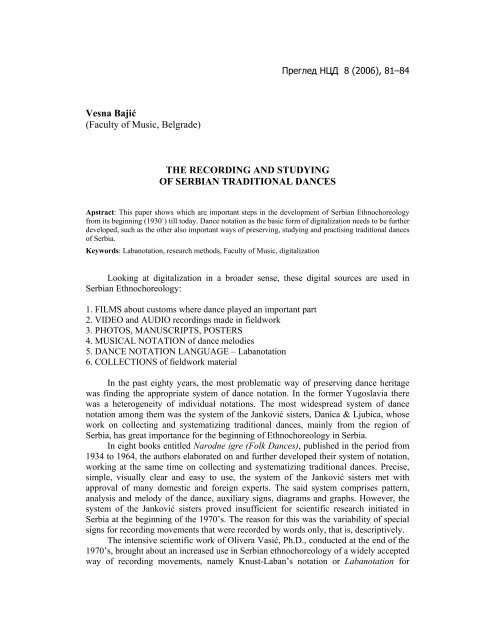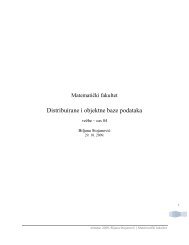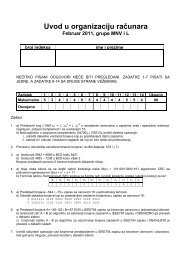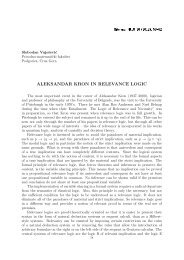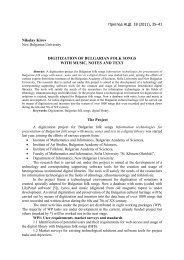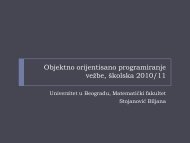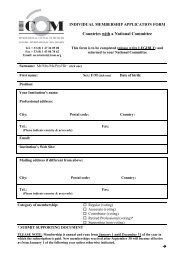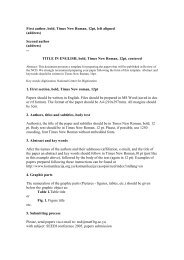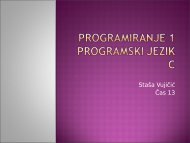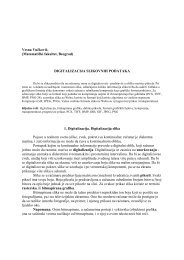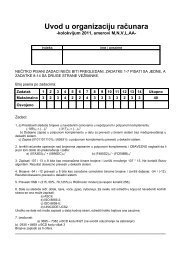Vesna BajiÄ (Faculty of Music, Belgrade) THE ... - Ncd.matf.bg.ac.rs
Vesna BajiÄ (Faculty of Music, Belgrade) THE ... - Ncd.matf.bg.ac.rs
Vesna BajiÄ (Faculty of Music, Belgrade) THE ... - Ncd.matf.bg.ac.rs
Create successful ePaper yourself
Turn your PDF publications into a flip-book with our unique Google optimized e-Paper software.
Преглед НЦД 8 (2006), 81–84<strong>Vesna</strong> Bajić(<strong>F<strong>ac</strong>ulty</strong> <strong>of</strong> <strong>Music</strong>, <strong>Belgrade</strong>)<strong>THE</strong> RECORDING AND STUDYINGOF SERBIAN TRADITIONAL DANCESApstr<strong>ac</strong>t: This paper shows which are important steps in the development <strong>of</strong> Serbian Ethnochoreologyfrom its beginning (1930`) till today. Dance notation as the basic form <strong>of</strong> digitalization needs to be furtherdeveloped, such as the other also important ways <strong>of</strong> preserving, studying and pr<strong>ac</strong>tising traditional dances<strong>of</strong> Serbia.Keywords: Labanotation, research methods, <strong>F<strong>ac</strong>ulty</strong> <strong>of</strong> <strong>Music</strong>, digitalizationLooking at digitalization in a broader sense, these digital sources are used inSerbian Ethnochoreology:1. FILMS about customs where dance played an important part2. VIDEO and AUDIO recordings made in fieldwork3. PHOTOS, MANUSCRIPTS, POSTERS4. MUSICAL NOTATION <strong>of</strong> dance melodies5. DANCE NOTATION LANGUAGE – Labanotation6. COLLECTIONS <strong>of</strong> fieldwork materialIn the past eighty yea<strong>rs</strong>, the most problematic way <strong>of</strong> preserving dance heritagewas finding the appropriate system <strong>of</strong> dance notation. In the former Yugoslavia therewas a heterogeneity <strong>of</strong> individual notations. The most widespread system <strong>of</strong> dancenotation among them was the system <strong>of</strong> the Janković siste<strong>rs</strong>, Danica & Ljubica, whosework on collecting and systematizing traditional dances, mainly from the region <strong>of</strong>Serbia, has great importance for the beginning <strong>of</strong> Ethnochoreology in Serbia.In eight books entitled Narodne igre (Folk Dances), published in the period from1934 to 1964, the autho<strong>rs</strong> elaborated on and further developed their system <strong>of</strong> notation,working at the same time on collecting and systematizing traditional dances. Precise,simple, visually clear and easy to use, the system <strong>of</strong> the Janković siste<strong>rs</strong> met withapproval <strong>of</strong> many domestic and foreign experts. The said system comprises pattern,analysis and melody <strong>of</strong> the dance, auxiliary signs, diagrams and graphs. However, thesystem <strong>of</strong> the Janković siste<strong>rs</strong> proved insufficient for scientific research initiated inSerbia at the beginning <strong>of</strong> the 1970’s. The reason for this was the variability <strong>of</strong> specialsigns for recording movements that were recorded by words only, that is, descriptively.The intensive scientific work <strong>of</strong> Olivera Vasić, Ph.D., conducted at the end <strong>of</strong> the1970’s, brought about an increased use in Serbian ethnochoreology <strong>of</strong> a widely <strong>ac</strong>ceptedway <strong>of</strong> recording movements, namely Knust-Laban’s notation or Labanotation for
82<strong>Vesna</strong> Bajićshort. Already in the 1950’s experts in the field <strong>of</strong> dance from the region <strong>of</strong> the formerYugoslavia became <strong>ac</strong>quainted with the principles <strong>of</strong> Labanotation and considered thepositive and negative aspects <strong>of</strong> its possible application in the future, albeit without anydefinite results. It was not until 1990, when the subject Ethnochoreology was introducedat the <strong>F<strong>ac</strong>ulty</strong> <strong>of</strong> <strong>Music</strong> as part <strong>of</strong> the general studies <strong>of</strong> ethnomusicology, that thestudents were presented with the opportunity to familiarize themselves, under theguidance <strong>of</strong> Pr<strong>of</strong>. Vasić, with a new kind <strong>of</strong> notation, Labanotation, which had by thenbecome standard in Europe. Up until today this system, which has been the basicstarting point in ethnochoreological works <strong>of</strong> different content and scope, has been inuse in regular studies.Labanotation uses a small number <strong>of</strong> signs that are logically pl<strong>ac</strong>ed in sp<strong>ac</strong>e andcan, <strong>ac</strong>cording to circumstances, be supplemented or modified so as to represent themost dive<strong>rs</strong>e movements <strong>of</strong> man as precisely as possible.With the foundation <strong>of</strong> the Centre for studying folk dances <strong>of</strong> Serbia at the <strong>F<strong>ac</strong>ulty</strong><strong>of</strong> <strong>Music</strong>, Labanotation became available to amateu<strong>rs</strong>, too. As part <strong>of</strong> a seminarorganized by the Centre, cou<strong>rs</strong>es on Labanotation are held on a regular basis and abooklet is published containing dances <strong>of</strong> a particular area written in this notation.However, Labanotation is very slowly gaining ground among choreographe<strong>rs</strong>, amateu<strong>rs</strong><strong>of</strong> traditional dance and amateur researche<strong>rs</strong>. Most <strong>of</strong> them find it unclear, abstr<strong>ac</strong>t andunpr<strong>ac</strong>tical which is why a safer method is still in use, namely description <strong>of</strong> the danceby words, <strong>of</strong>ten <strong>ac</strong>companied by individual signs. The reason behind this is inadequatetraining <strong>of</strong> the individual studying the dance and, on the other hand, the doubt whetherLabanotation can <strong>ac</strong>tually include every detail <strong>of</strong> the dance.The recording <strong>of</strong> dance and music is art <strong>of</strong> a particular kind and it requiresappropriate education. Unlike notating music, the recording <strong>of</strong> movements is morecomplex as dance is a temporal and spatial art. The notation <strong>of</strong> traditional dance consists<strong>of</strong> three basic constituents <strong>of</strong> dance, these being time, sp<strong>ac</strong>e and movement. Suchtridimensionality <strong>of</strong> dance translates into linearity on paper, which is a very complexand time-consuming job. In order to <strong>ac</strong>hieve objectivity in the scientific sense and atonce avoid subjectivity in description by words, it is necessary to keep developing thesign system. Individual systems <strong>of</strong> notation, starting from the Janković siste<strong>rs</strong>, must be“translated” into another, standard sign system such as Labanotation in order to avoidheterogeneity <strong>of</strong> individual notations. Only in this manner is the preservation <strong>of</strong> culturalheritage possible.When notating, one should consider every dance from all aspects: examine the title,area <strong>of</strong> diffusion, historical development, dance event (time and pl<strong>ac</strong>e <strong>of</strong> theperformance, participants, musical <strong>ac</strong>companiment) and record the dance pattern by thestandard system. Great attention should be paid to the recording <strong>of</strong> steps andmovements, their creation, way <strong>of</strong> transformation, variation, intertwining and dynamicand rhythmic complexities. This is fundamental to analytical work and to studyingdance units, micro- and m<strong>ac</strong>rostructure (motives, phrases, compositional models).With the adoption <strong>of</strong> Labanotation, Serbian ethnochoreology witnessed an increasedinterest in analytical work. Based on the recorded dances from the times <strong>of</strong> the Jankovićsiste<strong>rs</strong> and by transposing their notation into a new visual idiom, as well as based onsubsequent research that has continued up to the present, a systematization <strong>of</strong> the types<strong>of</strong> dance in Serbian dance heritage took pl<strong>ac</strong>e. Today’s most diffused type <strong>of</strong> Serbianfolk dance is kolo in three, which is usually shortened to kolo among the people. Withthe work on Labanotation special attention is called to the development <strong>of</strong> the dance
<strong>Vesna</strong> Bajić 83pattern from dichotomous to trichotomous structure, which is a char<strong>ac</strong>teristic <strong>of</strong> thistype <strong>of</strong> dance. Using a video recording, this process reveals a dive<strong>rs</strong>ity in embellishment(the enrichment <strong>of</strong> dance by leg movements), which is peculiar to Serbian danceheritage. Everything that can be detected on the basis <strong>of</strong> field recordings, even if itincludes individual creations <strong>of</strong> the folk dancer, is studied and recorded. Permeating thecollective and individual dance is that which could be termed style in ethnochoreology,and it directly points to the specificities <strong>of</strong> a particular ethnochoreological area.As the system <strong>of</strong> Labanotation had been precisely determined, a computer programcalled Calaban was designed in Europe in the 1990’s. Unfortunately, the Centre fo<strong>rs</strong>tudying folk dances <strong>of</strong> Serbia, as the only institution in Serbia that archives danceheritage, does not possess this program. Folk dances are still recorded manually, with apen and a ruler. The gathered field material is published through collections, whichcertainly is an important albeit not final step in organizing material. Computerprocessing would f<strong>ac</strong>ilitate the systematization and use <strong>of</strong> that material. In addition, theample video library <strong>of</strong> the Centre is privately owned by rare enthusiasts, seniorassociates <strong>of</strong> the Centre, because an appropriate strategy concerning the archiving <strong>of</strong>video recordings still does not exist. Forming an archive and its corresponding system isan important step in the development <strong>of</strong> Serbian ethnochoreology and efforts in thatfield are yet to be made. During the past two yea<strong>rs</strong> the Centre has published four videoeditions <strong>of</strong> certain dances <strong>of</strong> a particular region <strong>of</strong> Serbia.The preservation <strong>of</strong> cultural heritage is based not only on archiving material, butalso on its pr<strong>ac</strong>tical application. Young people have the opportunity to familiarizethemselves with the dance heritage <strong>of</strong> Serbia and other countries by virtue <strong>of</strong> a largenumber <strong>of</strong> cultural clubs, festivals and other events, but an appropriate governmentalinstitution that would educate pr<strong>of</strong>essional dance<strong>rs</strong> and ethnochoreologists, still does notexist. From October 2006 there will be changes in our education because a newdepartment for pedagogues <strong>of</strong> traditional dance will be opened in Kikinda, a town inVojvodina.This short presentation about the recording and studying <strong>of</strong> Serbian traditionaldances could show how much effort needs to be made and how many different mediaused to preserve only one aspect <strong>of</strong> cultural heritage – the dance. An oral tradition suchas dance needs to be studied, like traditional music, from many different aspects, but inthe absence <strong>of</strong> a serious, thought-out digital system, its preservation is not possible. Ihope that in collaboration with scientists from different institutions Ethnochoreologywill find the best way <strong>of</strong> developing.Весна Бајић(Факултет музичке уметности, Београд)ЗАПИСИВАЊЕ И ПРОУЧАВАЊЕ СРПСКИХ ТРАДИЦИОНАЛНИХ ИГАРАЗаписивање традиционалних игара у Србији започело је 30-их година XX века са првимосмишљеним системом чији су аутори биле сестре Даница и Љубица Јанковић, пионири српскеетнокореологије. У оквиру осам књига под називом Народне игре које су објављене у периоду1934–1964, ауторке су образложиле и даље усавршавале свој систем бележења радећи истовременона сакупљању и систематизовању традиционалних игара. Прецизан, једноставан,визуелно јасан и лак за примену, систем сестара Јанковић наишао је на одобравање многих нашихи страних стручњака. Међутим, за научна истраживања која су у Србији покренута почетком 70-ихгодина, систем сестара Јанковић показао се као недовољан. Разлог за то јесте непостојаностпосебних знакова за записивање покрета који су бележени искључиво речима, дескриптивно.
84<strong>Vesna</strong> BajićКрајем 70-их година са интензивним научним радом др Оливере Васић, у српскојетнокореологији се у већој мери почиње примењивати широко прихваћен начин записивањапокрета, Кнуст-Лабанова нотација или укратко лабанотација. Тек 1990. године, са увођењемпредмета етнокореологија на Факултету музичке уметности у оквиру основних студија етномузикологије,студенти су имали могућност да се под водством проф. Васић упознају са новим, уЕворпи тада већ стандардним начином записивања – лабанотацијом. Све до данас се на редовнимстудијама примењује овај систем који представља основну поставку у етнокореолошким радовимаразличитог садржаја и обима.Са оснивањем Центра за проучавање народних игара Србије при ФМУ, лабанотацијапостаје доступна и аматерима. У оквиру семинара које организује Центар редовно се одржавајукурсеви лабанотације и издаје се књижица у којој су игре одређене области записане овим писмом.Међутим, лабанотација се веома споро прихвата међу кореографима, љубитељима традиционалнеигре и истраживачима-аматерима. Већини је неразумљива, апстрактна и непрактична, зато се идаље користи сигурнији метод – описивање игре речима често праћено индивидуалним знаковима.Са усвајањем лабанотације у српској етнокореологији започело је све веће интересовањеза аналитички рад. На основу забележених игара од времена сестара Јанковић и транспоновањемњиховог записа у нови визуелни израз, као и на основу каснијих истраживања која се настављају иу данашње време, дошло се до систематизовања типова игара у српском играчком наслеђу.Прецизирањем система лабанотације, у Европи је 90-их година осмишљен компјутерскипрограм под називом Калабан. Центар за проучавање народних игара Србије, као једина институцијау Србији која се бави складиштењем играчког наслеђа, нажалост, још увек не поседује овајпрограм. Народне игре се и даље записују ручно – уз коришћење оловке и лењира. Прикупљенатеренска грађа се публикује у виду збирки, што је свакако важан али не и коначан корак усређивању материјала. Компјутерска обрада свакако би олакшала систематизацију и коришћење теграђе. Поред тога, богата видеотека Центра у приватном је власништву ретких ентузијаста,стручних сарадника Центра, из разлога што у погледу баштињења видео записа још увек непостоји одговарајућа стратегија. Формирање архива и њему одговарајућег система представљаважан корак у развоју српске етнокореологије и на том пољу тек предстоје напори.Очување културне баштине не темељи се само на архивирању материјала већ и у њенојпрактичној примени. Кроз велики број културно-уметничких друштава, фестивала и другихприредби млади имају могућности да се упознају са играчким наслеђем Србије и других земаља,али још увек не постоји одговарајућа државна институција која би школовала професионалнеиграче и етнокореологе. Од октобра 2006. године можемо се надати променама због отварањановог смера за образовање педагога традиционалних игара у Кикинди.vecili@ptt.yu


